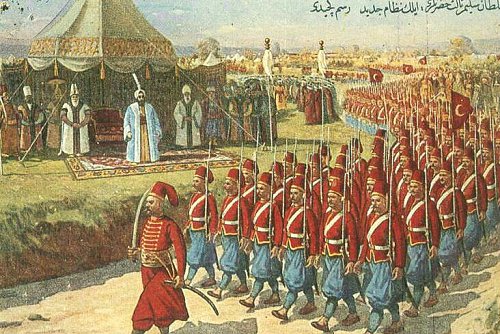
A comparative study of Ottoman hand firearms used by the Janissaries, that is, the Sultans’ elite infantry troops, shows that they were similar to the muskets the Ottomans’ Spanish and Venetian opponents used. For instance, the Ottomans adopted the Spanish miquelet lock. Despite these similarities, however,it is also reveals important differences, and argues that one field where the Ottomans lagged behind their European opponents was the lack of standardization. While standardization was hardly accomplished by the Europeans in general, the Austrians, and especially later the Russians, had considerably fewer caliber types within a certain class than the Ottomans did. This certainly made supply of ammunition a more difficult task in the Empire, and also hindered tactical reforms.
#
Ottoman military technological inferiority since the seventeenth century has been taken as an integral part of the Ottoman decline. Such a position is not warranted. Without a doubt the Turks lost battles, wars, and territory after 1683. Nevertheless, up to 1740 they also defeated Peter the Great, regained territory from the Venetians and Austrians, and held off the Iranians on a second front. These Ottoman victories may have owed a share to luck, but no more than their defeats owed to misfortune. The Russian victories over the Turks beginning in the 1770s should be attributed less to Russian technological superiority than to tactical innovation, since the wonder weapon turned out to be the bayonet. According to the Russian general Golitsyn, Turkish rifles “are longer, stouter and of better iron than those of the European but they make use of them slowly and are always impatient to charge the enemy with saber in hand . . . infantry fire doesn’t stop them. Only the bayonet represses their ardor.” Also, those Russian battles could easily have gone the other way, and contemporary opinion did not rule out Russian defeat in the first years of Catherine’s war.102 Finally, the rousing Otto man victory over the forces of revolutionary France in 1801 at the battle of El Honka in Egypt testified to the renewed vigor of the Turkish military.
Ottoman domestic war production rolled back on track by the end of the eighteenth century because the government became more systematic in recruiting the foreign technical personnel to overhaul its production facilities. In the 1780s, even before Selim III, the employment of foreign specialists in Ottoman establishments was becoming more regular. The French themselves eagerly desired to build up Ottoman naval and military strength, and French engineers and artisans super vised Ottoman manufacture of shells, bullets, ships, and artillery. As the British embassy reported, the “French Mission continues to solicit the Porte to hasten as much as possible her armaments, and preparations, by sea and land.” Herein lay the decisive improvement in acquiring the technical knowledge and integrating it into Ottoman domestic industry. Instead of relying on the random defection of skilled Europeans into Ottoman ranks, as they had done earlier in the century, beginning in the 1780s the Ottomans arranged with foreign states for formal missions to transfer the necessary techniques. As a result, the Ottomans obtained the most recent plans and models for their arsenals and dockyards. Selim III was able to build on this base when he initiated his reforms in the 1790s, and this closed the widening gap between the Porte and its rivals over the century. Problems remained with the Ottoman military establishment, but production had been restored.
From this examination of Ottoman war production capabilities it is evident that the Ottoman Empire experienced no inexorable decline after 1571 or 1683. Furthermore, the Ottomans managed to remain on par technologically with their main rivals, the Venetians and the Russians. Although Ottoman military production did lag behind the western European military technological developments during the eighteenth century, this state of affairs was not irreversible, and by the end of that century the Ottomans had succeeded in catching the wave of innovations. As we have seen, galleons, frigates, cannon boring techniques, light field guns, new-formula gunpowder, and flint lock firearms all found their way into Ottoman domestic manufacturing and use.
From the fifteenth to the eighteenth centuries the Ottomans managed to catch the first two diffusion waves of military technology, and each time they developed a domestic production capability derived from foreign expertise and copying foreign models. Although the techniques changed over time, the ability of the Ottomans to adopt new technologies remained consistent with the capacity of a third-tier producer throughout the period. In this light, the notion of Ottoman “decline” is inappropriate and misleading.
A case could be made, however, for a discernible Ottoman decline after 1850. At that time the Ottomans missed the next technological wave and actually began to lose their domestic production capabilities entirely. A presentation of the complete erosion of Ottoman war industries in the period 1854-1914 exceeds the scope of this essay. In brief, the dramatic and rapid changes in war technology, from repeater rifles to machine guns and from ironclads to dreadnoughts, combined with the development of the mass army, caused a financial strain that Turkish resources could not support. It became easier simply to restock with the newest imported weapons rather than lose time and money attempting to create and maintain a domestic arms industry. German Mauser rifles and Krupp artillery served as the standard issue for Ottoman forces, and British war ships made up the Turkish navy. By the late nineteenth century the Porte was completely dependent on foreign weapons imports and had fallen below the third-tier level. It seems an ironic inversion of the decline thesis to note that the period when the Ottomans were the most receptive to Western institutional borrowings turned out to be the time when the real decline to import dependency began.